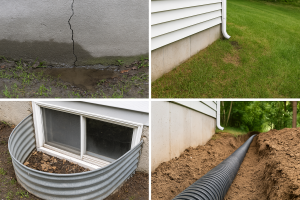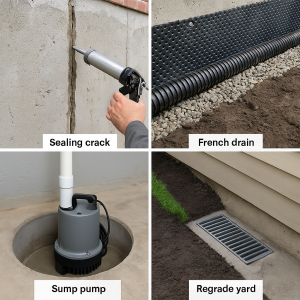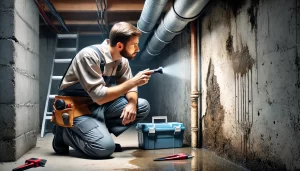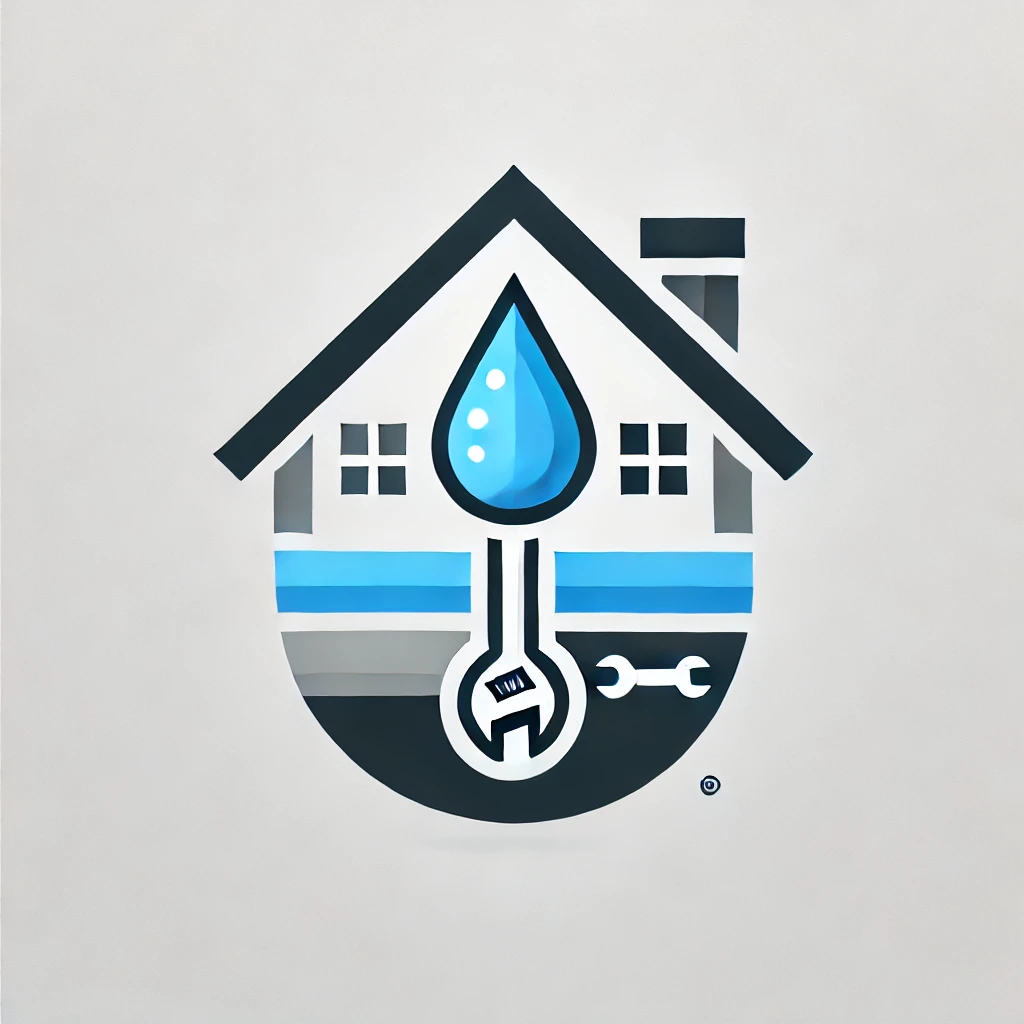Foundation water infiltration in Quebec: Protect your home

In Quebec, water infiltration through foundations is more common than many homeowners think—especially during spring thaw or after heavy rainfall. With Quebec’s harsh winters and rapid temperature changes, residential foundations endure intense pressure. If water infiltration is not identified and addressed promptly, it can cause serious damage such as mold growth, structural weakening, concrete erosion, and long-term repair costs.
This page covers the most common causes of infiltration, the best solutions to resolve the issue, and key prevention strategies. You’ll also learn when you should call a qualified plumber and where to find additional resources to better understand and manage water infiltration in your home.
By understanding the risk factors and available intervention methods, you can effectively protect your home from water infiltration. Whether you live in Montreal, Quebec City, a regional town, or a more rural area, these tips apply across the entire province. Moisture and water may seem harmless at first, but their impact on your home’s structure—and on the health of its occupants—should never be underestimated. The key lies in early detection, regular maintenance, and swift action at the first signs of trouble.
Common causes of water infiltration
 Before moving on to solutions and prevention methods, it's crucial to understand why and how water manages to infiltrate your foundations. Many factors come into play, and often several causes combine to make the situation worse. Here are some of the most common.
Before moving on to solutions and prevention methods, it's crucial to understand why and how water manages to infiltrate your foundations. Many factors come into play, and often several causes combine to make the situation worse. Here are some of the most common.
1. Foundation cracks
The extreme temperature variations typical of Quebec's climate put concrete and masonry structures to the test. Visit freezing and thawing These cracks can gradually widen. Over time, rainwater, melting snow or ambient humidity penetrate these cracks, which can lead to serious problems such as basement seepage. Cracks are often visible to the naked eye, but some, finer cracks or those hidden behind interior finishes, can go unnoticed for a long time.
It’s important to note that not all cracks are necessarily a sign of serious danger. Some shrinkage cracks in concrete can be relatively superficial. However, if a crack allows water to seep through or widens from one season to the next, it becomes urgent to seal it in order to prevent the water infiltration from worsening.
2. Poor slope of the land
The level and shape of the ground surrounding your home play a crucial role in protecting your foundation. When the terrain is uneven or slopes toward the house instead of away from it, the risk of water infiltration increases significantly. Over time, even a slight topographical imbalance can lead to water pooling at the base of exterior walls.
In some regions of Quebec, clay soils tend to swell and contract with humidity, which can affect natural drainage. Landscaping carried out over the years, the addition of a terrace or the construction of a parking lot can also alter the natural direction of water flow. You should therefore regularly check that the soil around your home slopes away from the foundation.
3. French drain blocked or missing
The French drain, also known as a foundation drain, is designed to collect groundwater and direct it away from the house. When functioning properly, it helps prevent moisture buildup around the foundation walls. However, if it becomes damaged or clogged with sediment, roots, or debris, water can accumulate and create hydrostatic pressure on the foundation—leading to infiltration.
Many older homes in Quebec have outdated or even non-existent French drains. Construction standards have evolved over time, and it's possible that some properties never had a proper drainage system in the first place. If you see traces of moisture along the inside base of the basement, a clogged or missing French drain is often to blame.
4. Poorly sealed window or coping joints
Basement windows—especially older ones—can be a potential entry point for water. If the frames or sealing joints are damaged, rainwater can seep in more easily. Window wells, designed to prevent soil from piling up around these openings, must be properly installed and maintained. Clogged wells filled with leaves or debris retain moisture and significantly increase the risk of infiltration.
Waterproofing materials, such as protective rubber or waterproof membranes, have a limited lifespan. In the Quebec context, with freeze-thaw cycles, it's a good idea to have them checked periodically. Preventive maintenance can save you a lot of trouble and costly repairs.
5. Faults in the outer waterproofing membrane
Many newer homes feature a sealing membrane applied to the foundation's exterior walls. This membrane acts as a barrier against moisture and infiltration. Over time, however, it can deteriorate, tear or delaminate, particularly under the effect of earth pressure and ground movement. Any perforation or crack in the membrane creates a direct path for water.
In older buildings, a waterproofing membrane may be partial or may have been poorly installed. Or it may simply not exist, since construction standards were not the same as today. When excavation work is required to repair or install a French drain, it's usually a good idea to take advantage of the opportunity to redo or improve the exterior waterproofing.
Solutions for correcting seepage
 If you notice water seeping into your basement or foundation, it's essential to act quickly to limit the damage. Different approaches can be considered, depending on the severity of the problem and the configuration of your building. Here are some common solutions:
If you notice water seeping into your basement or foundation, it's essential to act quickly to limit the damage. Different approaches can be considered, depending on the severity of the problem and the configuration of your building. Here are some common solutions:
1. Crack sealing
The first step in stopping infiltration is often to repair cracks. Professionals generally use epoxy or polyurethane injection techniques to seal openings in the concrete. In addition to being waterproof, these materials are flexible enough to accommodate slight movements of the foundation due to temperature variations.
It's crucial to call in an expert to assess the overall condition of the foundation. Sometimes, a visible crack is just the tip of the iceberg. A professional can ensure that the structure is still solid and that there are no other weak points to watch out for.
2. Cleaning, repairing or installing a French drain
A French drain is essential to evacuate the water that accumulates around the foundation. When the existing drain is blocked or damaged, cleaning with a high-pressure jet may suffice, provided the installation is still in good condition. In some cases, however, it may be necessary to replace or completely renovate the drain, which involves major excavation work.
In addition to restoring the performance of the French drain, it's often recommended to install a new external waterproofing membrane on the exposed foundation. This helps prevent future water infiltration and improves the overall durability of the structure. For an accurate diagnosis, you can schedule a camera inspection test with a certified plumber.
3. Installation of a pump or non-return valve system
In some areas of Quebec, the water table or the configuration of the terrain may make it difficult to evacuate water by gravity. A sump pump (or sump pump) can then be installed to expel the water from the house. This pump is usually placed in a sump dug at the lowest point of the basement, where water accumulates.
In addition, a check valve is often required to prevent sewer backups, especially when heavy rains saturate the municipal network. This device prevents water from flowing back into the house when sewer system pressure is too high. In many municipalities, installation of a non-return valve is even required by local regulations to obtain certain grants or permits.
4. Improved site drainage
If the problem is mainly due to poor ground levelling, it may be appropriate to rework the land around the house. This involves ensuring that the slope directs rainwater and run-off water away from the foundations. Gutters, gutters, paving stones and plantings can all be used to encourage the natural drainage of water.
In some cases, additional drainage, such as surface drains or ditches, may be required, especially if you live in an area prone to seasonal water accumulation. Before undertaking any such work, always check municipal by-laws and applicable standards.
5. Repairing or installing a waterproofing membrane
When the exterior waterproofing membrane is defective or non-existent, its installation or renovation is an effective solution for blocking water. This is more invasive work, as it often requires excavation around the house. However, this intervention generally corrects the source of the problem by creating a continuous barrier against humidity.
The opportunity is often taken to re-insulate the foundation with insulation boards and moisture-resistant materials. This is an ideal opportunity to improve the thermal comfort of your basement and extend the overall life of your home.
Besoin d’un diagnostic rapide ?
Protégez votre maison contre les infiltrations dès aujourd’hui. Obtenez une estimation gratuite auprès d’un plombier certifié dans Montréal dans votre région.
Long-term prevention
Like many household maintenance problems, the prevention is often more affordable and simpler than repair. Here are a few preventive measures to ensure the solidity of your foundations and reduce the risk of infiltration:
- Annual inspection : Visually check your foundation at least once a year, preferably in spring, to spot any cracks or signs of incipient damp.
- Gutter and downspout maintenance Make sure your eavestroughs are clear of leaves, debris and ice. Position eavestrough outlets at least 1.5 m from the house to prevent water from accumulating at the foot of walls.
- Regular French drain cleaning: A clogged drain quickly loses its efficiency. A plumber can help you check its condition and clean it if needed. With a camera inspection, it’s also possible to detect roots or other blockages inside the pipe.
- Surface water management The slope of the site must be maintained. Also, avoid parking heavy vehicles or stacking firewood too close to the house, as this can create areas of moisture accumulation.
- Indoor humidity control Use a dehumidifier in the basement if humidity levels are too high. This will prevent mold and protect your building materials.
By adopting these good practices, you'll extend the life of your home and reduce the risk of water damage, which can quickly become costly and compromise the health of your living spaces.
When should you call a qualified plumber?
 It can sometimes be difficult to know exactly when to contact a plumber or waterproofing expert. Here are a few situations that should alert you to seek professional advice:
It can sometimes be difficult to know exactly when to contact a plumber or waterproofing expert. Here are a few situations that should alert you to seek professional advice:
- Persistent humidity If you notice damp walls or a wet basement floor after a rain, don't wait for the situation to get worse.
- Appearance of stains or mold Molds release harmful spores and can affect indoor air quality. They often indicate infiltration or abnormal humidity levels.
- Musty or musty smell If an unpleasant odor persists in the basement, there's probably a problem with infiltration or inadequate ventilation.
- Growing cracks If you notice that a crack is widening or that new cracks are appearing, it's imperative to have the structure assessed by a professional.
- Sewer backup When it rains heavily and the municipal network is saturated, a faulty non-return valve can cause water to back up. In this case, a plumber should be consulted.
An experienced plumber or waterproofing specialist will be able to carry out an accurate diagnosis, whether by camera inspection, moisture testing or specialized probes. He or she will then be able to recommend the solutions best suited to your situation, whether it's sealing cracks, repairing a French drain or installing a sump pump.
If needed, you can visit SOS-Plombiers to learn more about the available services and request a quote. The plumbing experts are familiar with Quebec’s climate conditions and will guide you toward the best solution to fix and prevent any water infiltration issues.
Useful resources
To learn more about construction, foundation waterproofing and water management, visit the following websites:
You'll find additional information on foundation maintenance, subsidies that may be available, and tips on how to carry out certain work yourself or choose the right contractor. These resources are regularly updated, taking into account the province's specific climatic conditions.
In a nutshell water infiltration by foundations is not an uncommon phenomenon in France. QuebecThis is particularly true of our harsh climate and soil composition. However, they should never be taken lightly. What may seem like a simple problem of localized moisture can degenerate into a much more serious issue, jeopardizing the solidity of your property and the health of its occupants.
Understanding causes such as cracks, poor ground slope, faulty French drain or waterproofing membrane failure, allows you to act early and target the right solutions. Sealing cracks, repairing or installing a French drain, installing a membrane, adding a check valve or sump pump, and re-grading the soil are all ways to defend your home against water damage.
Long-term prevention is just as essential: regular maintenance, close monitoring for signs of moisture, and proactive repairs can help you avoid major expenses down the road. If in doubt, don’t hesitate to contact a qualified plumber or waterproofing specialist. These professionals are familiar with Quebec’s specific climate conditions and can recommend the most suitable interventions for your situation.
Finally, remember that vigilance is your best ally. Take the time to inspect your foundations and installations, especially after winter or episodes of heavy rain. By doing so, you protect the value of your investment and ensure the comfort and safety of your family. A well-sealed home is not only healthier, but also more energy-efficient and pleasant to live in. Don't let water find its way into your home: take the necessary steps to keep your foundations watertight, season after season.
Foire aux questions (FAQ)
